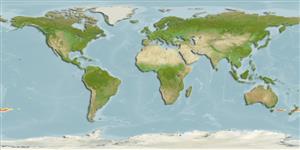>
Argentiniformes (Marine smelts) >
Opisthoproctidae (Barreleyes or spookfishes)
Etymology: Monacoa: The name constructed by Whitley was without any etymological reason; however, it is likely referring to the state of Monaco, in which the research expedition that sampled the two syntypes originated.; griseus: Name from Latin 'griseus' for 'grey'; referring to the uniform greyish anterior part of the sole lacking distinct patterns of pigmentation..
Environment: milieu / climate zone / depth range / distribution range
Ecología
marino batipelágico; rango de profundidad 0 - 521 m (Ref. 111070). Deep-water
Distribución
Países | Áreas FAO | Ecosistemas | Ocurrencias, apariciones | Point map | Introducciones | Faunafri
Southwest Pacific: New Zealand and possibly Australia.
Tamaño / Peso / Age
Maturity: Lm ? range ? - ? cm
Max length : 6.4 cm SL macho / no sexado; (Ref. 111070)
Short description
Morfología | Morfometría
This species is distinguished by the following characters: a greyish anterior part of the sole, abruptly changing just in front of the pelvic fins, to a dense pigmented posterior part; two adult specimens show in addition, a relatively weak irregular large blotch just in front of the change in pigmentation, centered approximately below the anterior part of the dorsal fin in the vertical plane; scale pockets possibly relatively light (Ref. 111070).
Life cycle and mating behavior
Madurez | Reproducción | Puesta | Huevos | Fecundidad | Larva
Poulsen, J.Y., T. Sado, C. Hahn, I. Byrkjedal, M. Moku and M. Miya, 2016. Preservation obscures pelagic deep-sea fish diversity: doubling the number of sole-bearing opisthoproctids and resurrection of the genus Monacoa (Opisthoproctidae, Argentiniformes). Plos One 11(8):1-23. (Ref. 111070)
IUCN Red List Status (Ref. 130435)
Threat to humans
Harmless
Human uses
Más información
PaísesÁreas FAOEcosistemasOcurrencias, aparicionesIntroduccionesStocksEcologíaDietacomponentes alimenticiosconsumo de alimentoRación
Nombres comunesSinónimosMetabolismoDespredadoresEcotoxicologíaReproducciónMadurezPuestaAgregación para la puestaFecundidadHuevosEgg development
Age/SizeCrecimientoLength-weightLength-lengthLength-frequenciesMorfometríaMorfologíaLarvaDinámica larvariaReclutamientoAbundanciaBRUVS
ReferenciasAcuiculturaPerfil de acuiculturaRazasGenéticaElectrophoresesheritabilidadEnfermedadesProcesamientoNutrientsMass conversion
ColaboradoresImágenesStamps, Coins Misc.SonidosCiguateraVelocidadTipo de nataciónSuperficie branquialOtolitosCerebrosVisión
Herramientas
Special reports
Download XML
Fuentes de Internet
Estimates based on models
Phylogenetic diversity index (Ref.
82804): PD
50 = 0.6250 [Uniqueness, from 0.5 = low to 2.0 = high].
Bayesian length-weight: a=0.02188 (0.00844 - 0.05670), b=2.98 (2.75 - 3.21), in cm total length, based on LWR estimates for this (Sub)family-body shape (Ref.
93245).
Nivel trófico (Ref.
69278): 3.4 ±0.1 se; based on size and trophs of closest relatives
Resiliencia (Ref.
120179): Alto, población duplicada en un tiempo mínimo inferior a 15 meses (Preliminary K or Fecundity.).
Fishing Vulnerability (Ref.
59153): Low vulnerability (10 of 100).
